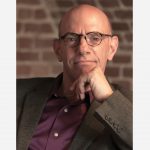Our Walk in the World: The Quarter Turn
I suddenly knew I was looking at it from the wrong angle and I gave the cloth in my hand a quarter turn.
Immediately I saw a beautiful and coherent golden pattern.
... In wonder, the pattern had emerged, to be seen in all its beauty by those who could learn to make the quarter turn.
—HELEN LUKE
Helen Luke was a mentor to me. The above quote is from her inner autobiography, Such Stuff as Dreams Are Made On. She begins the book with a dream in which one of her oldest friends, now gone, is asked on the other side to weave a tapestry that tells the story of her life.
But as Helen looks at the cloth, it makes no sense—until she gives the cloth a quarter turn and the pattern of her friend’s life emerges plainly.
Helen then offers the quarter turn as a synonym for a paradigm shift, as a way to understand those unexpected shifts of perception that return us to the hidden wholeness that knits life together. And like the fine-adjustment knob on a telescope or microscope that brings what you’re looking at into focus, the quarter turn is the skill of perception by which you can bring into focus the instrument that is you.
I experienced a profound quarter turn during my struggle with cancer. I was at one of many frightening ledges, needing to make another impossible decision. The tumor on my brain was pressing, and I had to say yes to surgery or chance waiting for further tests. Then, on October 4, 1987, we had an early, heavy snow in the midst of autumn’s full color. I woke that morning, tense and afraid of what lay ahead. When I looked into our yard, I saw that the early storm had brought all the trees down because the leaves, no matter how brilliant, had weighed the trees into snapping. If the leaves had let go, the snow would have left the trees standing. This was a paradigm shift for me, which caused me to see holding on and letting go differently. I stopped trying to maneuver my way through my cancer and began to grow slim as a leafless tree.
In the 1996 movie Phenomenon, starring John Travolta, mechanic George Malley sees a flash of light on his birthday and begins to experience extraordinary moments of far-reaching perception. The first of these sudden perceptions is a quarter turn. George is planting a small vegetable garden in his backyard, which has been plagued by a rabbit nibbling at all the stalks. George has tried everything to keep the rabbit out, from building a mesh fence to putting the fence deeper in the ground. One night, he wakes and quietly opens the gate to the garden. Then he waits on his porch and watches. After a while, the rabbit shows and leaves the garden under the moonlight. Sure enough—the rabbit wasn’t trying to get into the garden but trying to get out!
Sometimes, quarter turns defy any logical connection. As a young man, the poet Stanley Kunitz writes of being at a crossroads in life, needing to decide whether to devote himself to poetry or to pursue a more stable career. He was walking in a Pennsylvania field at dusk when, beyond all reason, he saw some geese sweep across a mottled sky. Intuitively, he knew the geese were saying yes, and he knew what he had to do.
Sometimes, quarter turns grow within us like seeds. During my cancer journey, I recalled being a boy of six or seven chasing a butterfly in a reservoir. When I finally caught it, I felt it flitting in my cupped hands, and it became clear that as long as I held it, I couldn’t see it. I had to let it go. When I did, its lightness and magnificence circled me. I quickly forgot the lesson. Until thirty years later, when overcome with fear that I would die. Then, the quarter turn came back to me. I realized that the fear thumping in my chest was like the butterfly cupped in my hands. As long as I kept the fear inside, I couldn’t see it. And so I tried to let it go, so it could mix with the quiet magnificence that was speaking to me from under my fear.
At the end of his life, the painter Raphael Soyer said, “I wish I had more eyes.” The only way to have more eyes is to stay open to the view from all of life’s positions. When we fall down, we must see from there. When lifted beyond our hopes, we must see from there. And when we fall down again, we must not forget the view of the lift. And when we are lifted again, we must not forget the view of the fallen. No one view is complete or permanent, and so, no one view is home. It’s the place from which we see that is home.
This excerpt is from Mark’s new book, Drinking from the River of Light: The Life of Expression (Sounds True, 2019).
A Question to Walk With
Explore a quarter turn that you have encountered.
First, describe an experience, event, or relationship that changed your way of seeing an important issue or problem. This is the trigger or catalyst of seeing differently.
Next, describe how your lens of perception shifted regarding the problem because of this trigger or catalyst. This is the actual shift in seeing that occurred in you.
Finally, describe how this new seeing enlarged who you are and how you see the world. What did the shift in seeing lead you to?
Read more from Mark Nepo here.
In January and February, Mark Nepo will be speaking and teaching at the Hudson Institute in Santa Barbara, CA, and at CIIS in San Francisco, CA. See MarkNepo.com for details.


